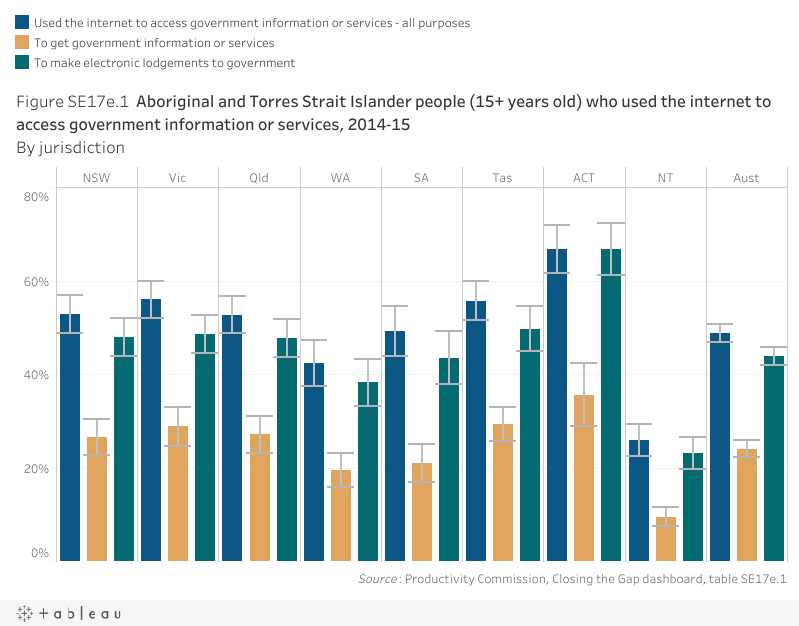Driver
Proportion of Aboriginal and Torres Strait Islander people using internet to access government services for private purposes
For example, health services, taxation, bill payments, social security payments
Data tables appear under figures
Measure
Proportion of people using the internet to access government services for private purposes
Nationally in 2014-15, 48.8% of all Aboriginal and Torres Strait Islander people aged 15 years or older used the internet to access government information or services for private purposes. Looking at different service types, 43.9% used the internet to make lodgements to government and 24.0% used the internet to get government information or services (figure SE17e.1).

Indicator data specifications
Related outcome: | Aboriginal and Torres Strait Islander people have access to information and services enabling participation in informed decision‑making regarding their own lives. |
|---|---|
Related target: | By 2026, Aboriginal and Torres Strait Islander people have equal levels of digital inclusion. |
Indicator: | Proportion of Aboriginal and Torres Strait Islander people using the internet to access government services for private purposes (e.g. health services, taxation, bill payments, social security payments) |
Measure: | The measure is defined as: Numerator – number of Aboriginal and Torres Strait Islander people aged 15 years and over who have accessed government services via the internet for private purposes in the last 12 months, by purpose for accessing Denominator – total number of Aboriginal and Torres Strait Islander people in the population aged 15 years and over and is presented as a percentage. |
Indicator established: | National Agreement on Closing the Gap 2020; indicator established April 2021 |
Latest dashboard update for the indicator: | 30 June 2022 |
Indicator type: | Driver |
Interpretation of change: | A high or increasing proportion is desirable. |
Data source(s): | Name: ABS National Aboriginal and Torres Strait Islander Social Survey (NATSISS) Frequency: Periodic Documentation (links): https://www.abs.gov.au/ausstats/abs@.nsf/Lookup/ by%20Subject/4714.0~2014-15~Main%20Features~Key%20findings~1 |
Data provider: | Provider name: Australian Bureau of Statistics Provider area: Centre for Aboriginal and Torres Strait Islander Statistics |
Baseline year: | 2014-15 |
Latest reporting period: | 2014-15 |
Disaggregations: | State and territory and Australia. |
Computation: | Numerator divided by Denominator multiplied by 100. Counting rules Data are for all Aboriginal and Torres Strait Islander people who were usual residents of private dwellings in Australia. Geographical variables are based on the location of the household. People aged 15 years and over who had accessed the internet in the previous 12 months were asked if they had used the internet to access government services for private purposes in the previous 12 months, and which ones.
The sum of proportions for reasons accessing government information or services may be greater than the total proportion of people accessing government information or services as a person may access information or services for multiple reasons. ABS TableBuilder has been used to source data for this indicator. Numbers in TableBuilder are rounded to the nearest 100. Proportions are calculated from rounded values. Includes (numerator):
Excludes (numerator):
Supporting calculations
See the How to interpret data for further information: https://www.pc.gov.au/closing-the-gap-data/how-to/interpret-data. Extraction TableBuilder – Age group – 15 years and over (Person level) X State or Territory (Household level) X Types of government services accessed via the internet for private purposes in last 12 months (Person level). |
Data quality considerations: | See NATSISS explanatory notes for further information: https://www.abs.gov.au/ ausstats/abs@.nsf/Latestproducts/4714.0Explanatory%20Notes12014-15?opendocument&tabname=Notes&prodno=4714.0&issue=2014-15 Data values have been randomly adjusted using perturbation to avoid the release of confidential data. Discrepancies may occur between sums of the component items and totals. Estimates that have a relative standard error between 25% and 50% should be used with caution. Estimates with a relative standard error of 50% or more are considered too unreliable for general use. Responses for ‘not known’ are combined with ‘did not access’ the internet in the last 12 months. Data for the ‘not known’ category are zero or close to zero (and considered ‘too unreliable for general use’) in every state and territory and nationally. There are no comparable non‑Indigenous data at present to determine progress to equal levels of digital inclusion. |
Future reporting: | Additional disaggregations required for future reporting:
|
